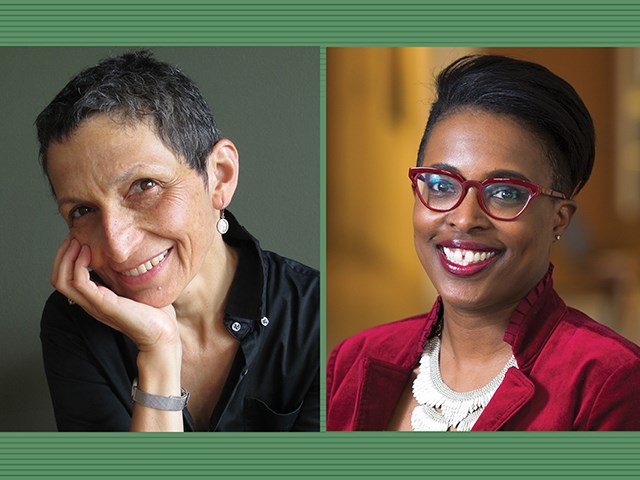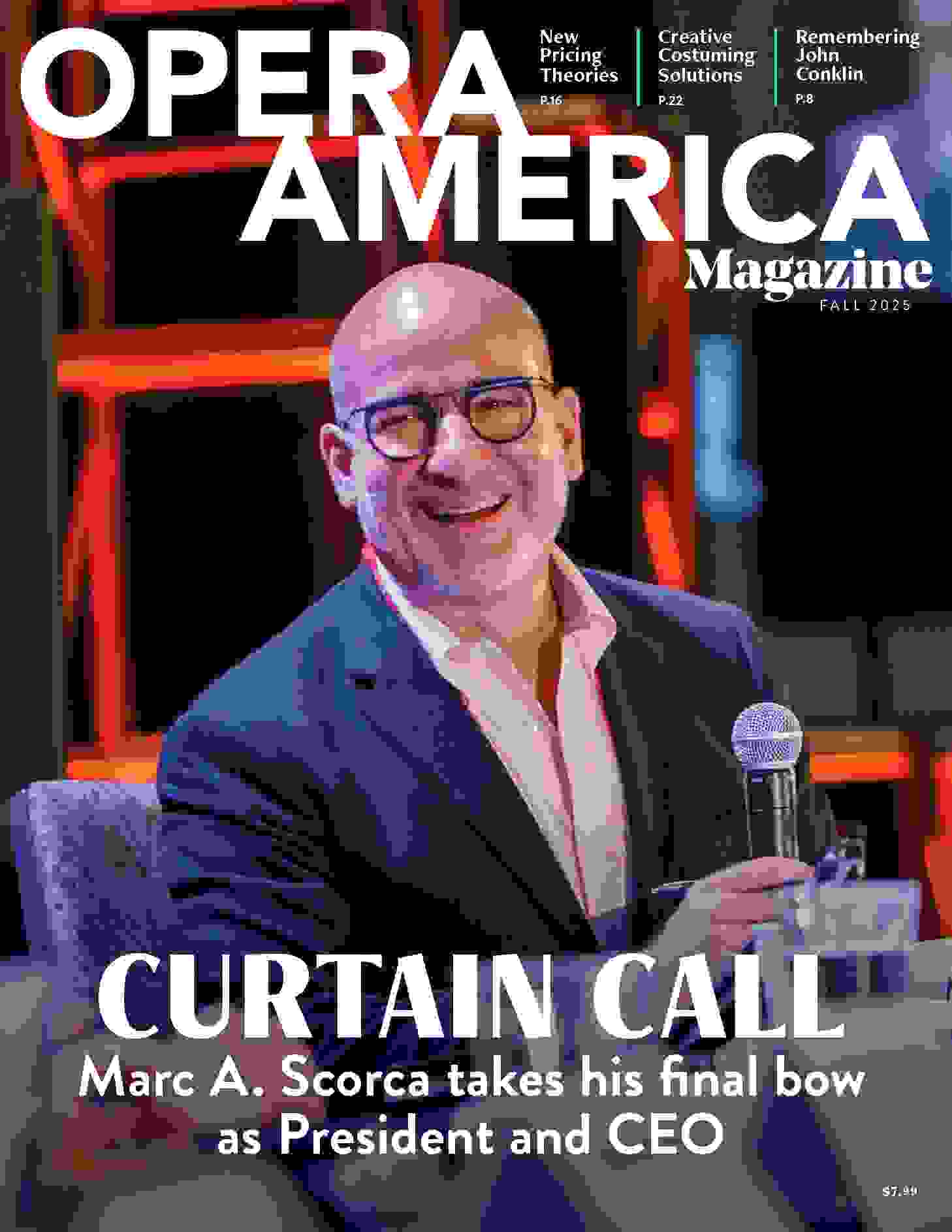Creating Belonging
Many of our inherited practices contribute to opera’s real and perceived elitism. In the boardroom, these practices often create barriers to the fruitful participation of new board members, especially those who are younger and more racially diverse.
OPERA America’s Marc A. Scorca spoke with Nadege Souvenir, Minnesota Opera’s board chair and COO of the Saint Paul & Minnesota Foundation, and Laura Kaminsky, the award-winning composer of As One, about how to empower new voices at the board table.

MARC A. SCORCA: Nadege, you’re the board chair of Minnesota Opera. Within the governance space, what are some of the inherited practices you have dismantled or wish to dismantle?
NADEGE SOUVENIR: One of the things I’d like to dismantle is the invisible rules of being a board member. I think we have started to do that at Minnesota Opera.
Lots of boards are talking about wanting to diversify, wanting to bring in young folks, wanting to bring in all categories of people. But they tend to bring new members in one at a time and don’t actually tell them all of the unwritten rules of engagement.
A board develops a culture over time, but when we bring new people in, we don’t tell them anything about the culture. And then we whisper behind their back and say, “They don’t really fit in” and “They should finish their first term, and maybe not return.” It would be easier for new folks to find their way through and stay if we could get rid of that practice.
MARC: Would you be willing to share what your experience was when you first joined the Minnesota Opera board?
NADEGE: I’ve been affiliated with the Minnesota Opera board for quite some time, and I will not pretend that my first years were easy. They were hard. It was microaggression after microaggression. It was feeling as though I was not part of the group, like I was sitting in the corner. There was satisfaction in having “diversified” the board, but no real effort at inclusion. They were happy to have me in the room because my presence checked off a few boxes — I am Black, and I was young back then! But, you know, nobody asked me for my thoughts and my opinions.
MARC: Laura, you used to work with nonprofit boards as an artistic director. Now as a full-time composer, have you served on any boards?
LAURA KAMINSKY: Everything Nadege has said rings so true. I have served on several boards, including some where I was the only artist. Often I would speak up about what artists actually needed from the institution and how the board could help with that. But my voice didn’t always seem to be heard, probably because it was just me as the lone artist. If I had another peer to reinforce what I was saying, perhaps it would have been less daunting to shift the focus of the discussion.
NADEGE: Maybe I’m stubborn; I stuck it out on the Minnesota Opera board. I’m glad I did; I’m quite proud of how far the organization has come. But most people don’t stick it out. I pay for the privilege of being a board member. Think about that: You are inviting someone into a space who is paying for the “privilege” of being handed microaggressions, being excluded, being put to the side. The reality is that as a Black woman, I have to deal with way too much bad behavior in my everyday life; why would I pay for that kind of experience on a volunteer board? Would you ever do that? Would you say, “Let me write you that $10,000 check so that you can treat me poorly”?
Ultimately, you need to acknowledge who and what you are as a board. As you bring new people in, invite them in and make space for who they are. And you’ve got to give them all the rules. You can’t keep an invisible set in your pocket and then say, “Eh, it didn’t work.”
MARC: I want to explore what you just said. We need to tell new board members how it works: what’s the culture, how the rules operate. But we also don’t want to perpetuate assimilation by forcing them not to be themselves. How do we make space for newcomers to be who they are within the context of our rule-bound structure?
NADEGE: While that seems like the million-dollar question that everybody needs to figure out, the reality is we know how to do this. We do this all the time. We do this in our social networks. Your neighborhood might have some norms, but when a new neighbor moves into the neighborhood, they bring new things. Two years from now, the norms include the things they brought.
It’s really fascinating to me that we completely forget how to do this in the context of the boardroom when it comes to younger and racially diverse members. When we are in other settings, we know how to do this on a person-to-person level. It might sound sort of basic or silly, but let’s pretend we’re kindergartners, because they do it right. When a new kid comes along, they make space in the circle and invite the new kid in as they are. It’s just that simple: What you do in other aspects of your life can be done in the more structured boardroom.
LAURA: There’s something underneath all of this that I’m not sure we’re quite addressing. There’s still an implication that if we do it right — meaning doing it as well as possible within the conventional ways that opera is presented and doing it within the established structures — then we will have more of what we still think of as opera, or that opera as we know it will be better. But the essential, in fact existential, question is: Do we want more and better, or do we want change?
Bringing in people to a board who may not have had board experience and teaching them what the hidden secret codes are on the board gives them the ability to be in that cult. But we don’t want to be in a cult, right? We want to be in a welcoming church. So the board members, who already have their secret codes and behaviors, need to learn that some of these are really off-putting and need to go away.
When you go into a space, there are always some kind of rules. The courtesy is to teach the rules. But you’re right — real inclusion means revising or even getting rid of some of those rules.
NADEGE: I completely agree with you. When you go into a space, there are always some kind of rules. The courtesy is to teach the rules. But you’re right — real inclusion means revising or even getting rid of some of those rules.
MARC: Nadege, is there anything you’ve done at Minnesota Opera or at the Saint Paul & Minnesota Foundation to start breaking down these board rules? Have you found ways to give voice to people who don’t normally get a voice?
NADEGE: There is a cloak of secrecy that exists around trustees. Maybe the leadership team sits in on the board meetings. Maybe it’s just the CEO or the general director. At my foundation, we’ve recently started opening up our board meetings to staff. Now, we obviously cannot have 80 people in a room at the same time. But using Zoom, we have some staff watch remotely.
After the board meeting, I meet with those staff members. They ask questions. They make comments and observations. I circle back to the board with those comments. I think it has been helpful both for the staff members and for the board, because they’re more cognizant of the fact that they don’t operate in some invisible silo at the top of a castle. They operate as a collective part of the whole. I think that’s one of the biggest invisible rules we should get away from. It’s a circle; everybody’s got a role in that circle.
MARC: I love how you’ve created a space for staff to bring their voices to the board. Imagine if a board chair took the time to sit down with new board members after every meeting — to ensure that they had a space to speak up!
LAURA: Yes, there are inherited structures that we don’t think about. There’s a buddy system on many boards, for example, for new board members to be paired with veterans. What if there were a buddy system of one staff member to one board member? There has to be a way that everybody is invested and really belongs. That takes away the structures that exist as barriers.
And that goes also to the actual making of opera and putting it on a stage. Some of the best ideas have come from the costume designer or assistant stage manager who is watching a workshop. Their reaction or question sparks a conversation among the librettist, the composer, and the director. Their input has the potential to change the piece. Those are valid, thoughtful, impassioned professionals who care, but because of the hierarchical nature in which operas are brought to the stage, they’re usually not supposed to talk — but they should talk, and all those involved should listen. Ultimately, for opera to be successful and vibrant as an art form, it needs to be collaborative and welcoming for all: creators, artists, administrators, board, and audiences.
Adapted from the session “Dismantling Opera’s Elitism” at Opera Conference 2022 in Minneapolis.
This article was published in the Fall/Winter 2022 issue of Across the Board, a publication of OPERA America for opera company trustees.





